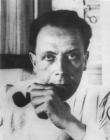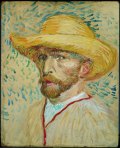Happy Birthday Max Weber
 In the first two decades of the twentieth century it is difficult to overstate the influence Alfred Stieglitz and his 291 Gallery had on cutting edge art in this country. There was virtually no Avant-garde artist working in the United States (meaning New York City) that wasn’t intimately connected with Stieglitz, or hadn’t at least exhibited at 291 Fifth Avenue. The typical routine tended to be that they were “discovered” by Stieglitz, went to Europe, (Paris and/or Munich) studied Matisse, Cézanne, Picasso, Delaunay, Kandinsky, and a few others, then came back carrying with them an amalgamation of many of these styles to try and make a go of it in this country. This group included artists such as John Marin, Arthur Dove, Marden Hartley, and Max Weber among others.
In the first two decades of the twentieth century it is difficult to overstate the influence Alfred Stieglitz and his 291 Gallery had on cutting edge art in this country. There was virtually no Avant-garde artist working in the United States (meaning New York City) that wasn’t intimately connected with Stieglitz, or hadn’t at least exhibited at 291 Fifth Avenue. The typical routine tended to be that they were “discovered” by Stieglitz, went to Europe, (Paris and/or Munich) studied Matisse, Cézanne, Picasso, Delaunay, Kandinsky, and a few others, then came back carrying with them an amalgamation of many of these styles to try and make a go of it in this country. This group included artists such as John Marin, Arthur Dove, Marden Hartley, and Max Weber among others.
Weber is an interesting case study. Born in 1881 in Bialystok, Russia, his Jewish parents brought him to this country when he was ten. He grew up poor in Brooklyn where he attended the Pratt Institute. There he studied under Arthur Wesley Dow who had worked with Gauguin. From Dow he picked up an emphasis on structure and patterned design. As was typical of the time, he went to Paris to complete his art studies, working under Robert Delaunay while studying the Fauves, Cézanne, and apparently Cubism, given the similarities between his Composition with Three Figures painted in 1910, and Picasso’s 1907 Les Demoiselles d’ Avignon. The Cubist and African influence is unmistakable.
He returned to New York in 1908. His big break came three years later when Stieglitz invited him to exhibit at the 291 Gallery. However two years after that, some of his paintings were refused at the 1913 Armory Show. In a fit of pique, he withdrew them all. It was a major career blunder. He went unrepresented in the most important Avant-garde show of his time. The next few years were difficult for him. In his painting Chinese Restaurant (1915), we find him experimenting with Synthetic Cubism, and in the same year, in painting Rush Hour, New York, there is the element of Futurism as he attempted to capture the powerful rhythms of the streets in abstract form. But as with many artists who are ahead of their time, Weber suffered for it. Critics had nothing good to say about any of his work. Everyone else ignored him. Disillusioned and broke, Weber gradually turned to representational images in the early 1920s, letting Surrealism, Abstract Expressionism, and a number of other art movements pass him by. By the time of his death in 1961, he was largely forgotten.
contributed by Lane, Jim
 Leonardo di ser Piero da Vinci (
Leonardo di ser Piero da Vinci (  James Sidney Ensor was born in Ostend, Belgium, on April 13 1860 and — except for three years spent at the Brussels Academy, from 1877 to 1879 — he lived in Ostend all his life. His parents owned a souvenir shop.
James Sidney Ensor was born in Ostend, Belgium, on April 13 1860 and — except for three years spent at the Brussels Academy, from 1877 to 1879 — he lived in Ostend all his life. His parents owned a souvenir shop.




